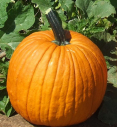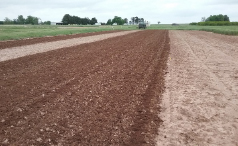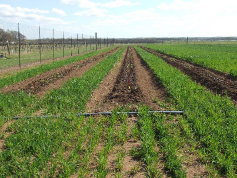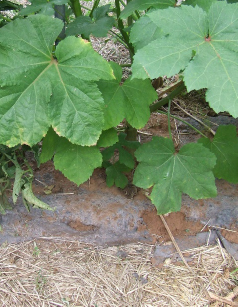Squash and Pumpkin Production
- Jump To:
- Origin and Families
- Nutritional Content
- Production Requirements
- Sites and Soils
- Soil pH and Fertilizer
- Planting and Plant Spacing
- Weed Management
- Irrigation
- Field Scouting for Plant and Pest Development
- Insects
- Diseases
- Pesticide Applications
- Harvesting and Handling
- Curing and Storage
- Related Extension Publications
Origin and Families
Squash and pumpkin originated in the Americas including parts of South America, Mexico and Central America. Well before they were adopted by Europeans, the seed of these important crops were carried into northern regions of the Americas by Native Americans to be grown as important food crops (Peirce, 1987). This group of cucurbits includes members from Cucurbita maxima (i.e., winter squash), C. pepo (summer squash, pumpkin), C. moschata (squash and pumpkins with narrow necks) and C. mixta (cushaws and pear-shaped pumpkins).

Nutritional Content
Orange-fleshed pumpkins contain significant levels of vitamin A along with calcium and folate. Other squash relatives, including summer and zucchini squashes, have lower levels of calcium, folate and vitamin A (https://ndb.nal.usda.gov/ndb/search/list). Additionally, pumpkin seeds can be roasted and eaten as a nutritious snack that contains both energy and protein.
Production Requirements
Squash is grown in Oklahoma for both fresh and processing markets and can be grown in all areas of the state. These crops prefer low humidity conditions due to lower incidence of fruit and foliar disease. In general, cucurbits such as squash and pumpkin perform best during warm weather, flowering and fruiting during the heat of summer, while less heat-tolerant crops cease to flower or fruit.
Flowering is monoicous, meaning there are separate male and female flowers on the same plant. What that means for fruit production is that pollen from the male flowers must be transferred onto the stigma of the female flower primarily by insect pollinators, therefore, protecting and managing pollinator insects is critical for fruiting. Better pollination translates to more seeds formed in the fruit, and therefore larger fruit within a given species.
Squash and pumpkin production are limited by high labor requirements for harvesting and difficulty in controlling virus diseases. There is evidence that the use of sorghum x Sudangrass or other annual warm-season forage grasses can reduce the level of virus in cucurbit crops when planted as windrows between rows of squash.
Good yield for summer squash under irrigation in Oklahoma is 8 tons per acre or 400 bushel cartons. With good management and growing conditions, winter squash and pumpkin will yield 12 tons per acre or more. Yields of 15 to 20 tons per acre of pumpkin are possible.
Sites and Soils
Soil types for squash production can vary, with loams and sandy loams preferred. If soil drainage is less than optimal, squash will benefit from the formation of free-standing raised soil beds. These beds can be formed by using a commercial bed-shaper. Drip irrigation tape can be installed with most bed-shapers during bedding. Squash will produce higher yields if supplemental irrigation is available during drought conditions, which occur during most summer growing seasons. Nematodes can be a problem and producers should rotate squash fields to non-host species such as annual grasses or cereal grains to reduce the chances of nematode populations increasing.
Soil pH and Fertilizer
Squash is tolerant to a wide range of soil pH, but soil with a pH between 6.0 and 6.8 is preferred. If the soil pH is below 5.8, it should be limed to increase the pH to 6.0 or above. Based on OSU soil test results, recommended amounts of phosphorus (P2O5) and potassium (K2O) are given in Table 1.
Table 1. Phosphorous and potassium requirements for squash.
| Phosphorous Requirements (lbs. P2O5/Acre) | ||||||
| When test shows | 0 | 10 | 20 | 40 | >65 | |
| Add lbs. P2O5 | 120 | 100 | 80 | 45 | 0 | |
| Potassium Requirements (lbs. K2O/Acre) | ||||||
| When test shows | 0 | 75 | 125 | 200 | >250 | |
| Add lbs. K2O | 120 | 100 | 80 | 40 | 0 |
Nitrogen
The nitrate-N value given by the soil test report should be used to determine nitrogen fertilizer needs on a particular soil. Subtract the available nitrogen given in the soil test results from that needed initially by the crop. For example, if the soil test indicates 15 pounds of available nitrogen, subtract that 15 pounds from the pre-plant nitrogen application of 50 pounds, meaning 35 pounds of nitrogen would need to be applied prior to planting. On soils with low levels (5 pounds or less) of nitrogen, apply 50 pounds nitrogen per acre pre-plant incorporated, along with recommended P2O5 and K2O (Table 1) prior to planting. Alternatively, band all fertilizer with the planter 3 to 4 inches below and 2 to 3 inches to the side of the seed row. High levels of N in the soil will cause excessive growth and delayed flowering and fruit set; therefore, do not over-apply nitrogen. Squash will respond to N fertilizer, so top-dressing (applying fertilizer to the soil surface) with N fertilizer is advised. Two top-dresses of 40 pounds nitrogen per acre for each top-dress, with the first at three weeks after seedling emergence and the last three weeks later should supply ample nitrogen for the crop. Another method of managing nitrogen is to inject it through a drip irrigation system, if an irrigation system is used for crop watering. The advantage of applying nitrogen through the drip system is that smaller amounts of nitrogen can be applied on a more regular basis, thereby reducing the risk of over-applying nitrogen and reducing nitrogen loss from leaching by heavy rains. In addition, less nitrogen will be available for weedy competitors since nitrogen applied through the drip system is applied down the row, not broadcast over a wider area. Even if fertilizer is injected through the drip irrigation system, it is wise to make a pre-plant application of nitrogen, phosphorus and potassium based upon soil test recommendations, or apply all of them through the drip irrigation system if a water-soluble complete fertilizer (fertilizer containing N-P-K) is used.
Soil Preparation
Conventional clean tillage methods can be used for soil preparation including deep-plowing, disking and harrowing. An alternative to tilling the entire field area would be to strip-till, where a cool season cover crop strip is left between every two to four rows of squash, allowing for wind-breaks and later for harvest and spray alleys if spraying is necessary.
One potential challenge with conventional clean tillage is the loss of soil organic matter due to the physical cutting-up of organic residues and the increase of soil microbial activity in breaking down organic residues. One solution to this loss of organic matter would be the use of winter cover crops to increase soil organic matter. When a winter legume such as Austrian winter pea or winter clovers, etc. are included with a cereal grass in the cover crop mix, not only will soil organic matter be increased, but there will also be a gain in available nitrogen for subsequent warm-season crops such as squash.
Research has indicated a direct benefit to using cover crops with at least one legume in the cover crop mix in the winter prior to planting a warm-season crop such as squash or pumpkin. In an organic system, legume cover crops are a good source of nitrogen that will be available for an extended period during the growing season.

Figure 1. Conventional tillage

Figure 2. Strip tillage
Planting and Plant Spacing
A key aspect of establishing squash is waiting until the soil temperature at planting depth is at least 60 F (70 to 90 F for optimal germination temperature), otherwise plants will be slow to emerge and crop stands will be variable, with plants in various stages of growth. In addition, cold soil temperatures early in the season can result in blossom end rot (BER). Blossom end rot is a physiological condition where calcium is reduced in availability during flowering and fruiting, resulting in a brown, leathery area on the bottom (blossom end) of the fruit, rendering the fruit unsaleable. Blossom end rot usually occurs at early set fruit and is related to several conditions, with cold soils being a major factor.
Direct seeding is the primary method used for crop establishment. Seed squash approximately ¾ to 1 inch in depth in rows 42 inches apart for dwarf types and 48 to 60 inches apart for medium to large types. Seed should be spaced 3 to 4 inches apart in the row, then thinned to 12 to 15 inches apart for dwarf types and 18 to 24 inches apart for standard and large types. Summer and winter squash and pumpkin varieties are provided in Table 2. The most recent OSU variety recommendations can be found in HLA-6035, Commercial Vegetable Varieties for Oklahoma.
Table 2. Squash and pumpkin varieties.
| Summer Squash Varieties | Type | |
| Peter Pan | Green scallop | |
| Sunburst | Yellow scallop | |
| Prelude II | Yellow crookneck | |
| Sunglo | Yellow crookneck | |
| Supersett | Yellow crookneck | |
| Fortune | Yellow straight-neck | |
| Superpik | Yellow straight-neck | |
| CashFlow | Green zucchini | |
| Dividend | Green zucchini | |
| Payroll | Green zucchini | |
| Winter Squash Varieties | Type | |
| Autumn Delight | Green acorn | |
| TayBelle | Green acorn PM resistant* | |
| Bonbon | Buttercup | |
| Burgess Buttercup | Buttercup | |
| Chieftain | Butternut PM resistant | |
| Ultra HP Premium | Butternut | |
| Waltham Butternut | Butternut | |
| Pumpkin Varieties | Type | |
| Howden | Field | |
| Mustang | Field PM resistant | |
| Charisma | Field PM resistant | |
| Magician | Field | |
| Orange Smoothie | Pie | |
| Winter Luxury | Pie | |
| Touch of Autumn | Small |
PM resistant* = Powdery Mildew resistance
Transplants of squash can also be used for establishment and will take approximately four weeks to produce prior to transplanting in the field. See HLA-6020, Growing Vegetable Transplants for more information. Unless the producer is targeting a very early market, transplants aren’t normally used as the large-seeded squash and pumpkins germinate and grow rapidly when soil temperatures are conducive to germination. Transplanting into raised beds covered with black plastic mulch will reduce the time to harvest, particularly during cool, wet springs.
Weed Management
Whether using conventional clean tillage, strip tillage or mulches, producers will encounter weed competition when producing squash and pumpkin. Weed control will be critical in the early growth stages, while seedlings or transplants are small. Shallow cultivation by tractor-drawn cultivators, hoeing by hand or walk-behind tillers will be required in the early stages of crop development in an organic system and also may be needed in conventional production. When cultivating, be certain to cultivate at a depth that is shallow, but deep enough to be effective for weed control, since deep cultivation will damage crop roots and bring more weed seed to the surface. After the crop begins to shade the soil surface, less cultivation will be needed to maintain the field due to the ability of squash and pumpkins to shade the soil surface. Further control of weedy species can be attained through the use of organic mulches once soil temperature has increased and crop growth is rapid. Some organic mulching materials during decomposition can compete directly with the crop for nitrogen, therefore don’t use mulches with high carbon-to-nitrogen ratios (bark, wood chips or ground wood products). In addition, the need for tillage can be reduced considerably if pre-emergence or post-emergence herbicides are a viable option for the farm. Registered herbicides for squash and pumpkin can be found in E-832, Extension Agents’ Handbook of Insect, Plant Disease, and Weed Control. As with any pesticide, be certain to read and follow label instructions pertaining to what crops it can be used with and how to safely store and use the material.

Figure 3. Organic mulch
Irrigation
Adequate moisture is needed by all crops to grow and flourish. Moisture stress during summer squash harvest can seriously reduce yield. When overhead irrigation is used, water should be applied early in the day so leaves can dry before nightfall to reduce the incidence of fruit rot and foliar diseases. Although squash and pumpkin are crops that can tolerate both heat and some drought, these crops will not maximize their potential for yield and profitability if they are drought stressed. Irrigation is needed when the crop is not receiving adequate rainfall to meet its needs. If adequate rainfall is lacking, it will be necessary to provide supplemental irrigation totaling 1.5 inches of water every 10 days during the hottest months of the summer.
Water can be delivered to the crop in a number of ways, including overhead sprinklers, furrow irrigation and drip systems. Drip irrigation often is used in situations where there is not adequate water volume or pressure to meet the higher use requirements for overhead systems. Drip systems are a very efficient means of distributing irrigation water, since water is either applied to the surface of the soil or subsurface with buried drip tape. Other benefits to drip irrigation include being able to carry on other field operations during irrigation; not wetting the crop foliage, thereby reducing crop disease pressure; and being able to fertilize through the drip system. Irrigate summer squash with moderate amounts of water since they root only 3 to 4 feet deep, but have many shallow roots. Winter squash and pumpkin root deeper and require less frequent irrigation.
Field Scouting for Plant and Pest Development
Fields should be scouted at a minimum of once per week after planting by walking across the entire field in a V-shape or X-shape pattern and recording plant development and weed and insect occurrence and numbers. Results of surveys will be needed to make decisions regarding projection of harvest date, the need to bring in honey bees for pollination and pest control.
If known, scout for diseases in areas of a field in which diseases tend to appear first. Otherwise, use the V-shape or X-shape sampling pattern outlined for insects. Some foliar diseases will appear where air circulation is reduced and leaves remain wet, such as in low areas and along borders sheltered by trees. Foliar diseases typically appear first on crown leaves close to the base of the main stem. Root diseases tend to appear where soil remains wettest, such as in low areas and in heavier soils.
Insects
Fields previously in sod or having heavy infestations of weeds the prior year should be treated with a soil-applied insecticide at planting to control soil insect pests, including cutworms. Small seedlings are extremely susceptible to feeding damage from striped and spotted cucumber beetles, which transmit bacterial wilt. Seedlings may need to be treated with a foliar-applied insecticide to prevent complete defoliation and/or infection from bacterial wilt.
Squash bug is the key pest of squash and pumpkins and will destroy the crop if not controlled. Squash bugs must be controlled early in the growing season and can best be located by examining the underside of leaves for eggs, which are laid in groups. Young nymphs are the easiest life stage to control and should be targeted for insecticide applications. Nymphs are most easily located in close proximity to egg clusters just after hatching. Aphids and mites can cause damage to leaves and they leave deposits on fruit, reducing marketable yield. Low numbers can be tolerated throughout most of the season, and scouting results will indicate whether populations are increasing and should be controlled.
Good fruit set and development on squash and pumpkins are dependent upon insects, primarily honey bees and bumble bees, to adequately pollinate the female flowers. Flowers are most receptive to pollination during the morning hours. Flowers should be examined to determine activity of bees. If less than one bee per 10 flowers is noted during the morning hours, the producer should bring bee hives into the field to ensure adequate pollination.
Diseases
Squash and pumpkin are susceptible to several diseases that attack the roots, foliage and fruit. The most common diseases in Oklahoma have been powdery mildew and virus diseases. Angular leaf spot, downy mildew, Phytophthora rot, other fruit rots, bacterial wilt, root rots/vine declines and root-knot nematode also have been problems.
Disease control is essential in the production of high quality squash and pumpkin. A preventive program that combines the use of cultural practices, genetic resistance and chemical control as needed, usually provides the best results.
Cultural practices are useful for limiting the establishment, spread and survival of pathogen that cause squash and pumpkin diseases. Many of the fungal, bacterial and nematode pathogens survive in old crop debris and in the soil. Fields should be rotated with non-cucurbit crops for at least three years to reduce pathogen levels. Grass crops are ideal for rotations where nematodes are a problem. Fields with the proper soil characteristics should be selected. Avoid acid soils or fields with a history of Phytophthora rot or root rots/vine declines. The selection of well-drained soils is essential for minimizing fruit rots. Late plantings should not be situated nearby and downwind of early planted cucurbit fields, where foliar or virus diseases already exist. Avoid the movement of contaminated soil or plant debris on workers or farm equipment into clean fields. Diseases such as angular leaf spot are known to be carried on seed. This can lead to the introduction of disease into fields. Purchase seed from reputable sources and apply a fungicide seed treatment prior to planting. Most foliar diseases are spread by water-splash or favored by long periods of leaf wetness. Utilize drip irrigation or avoid frequent sprinkler irrigation with small amounts of water. Finally, use tillage practices that promote the rapid decomposition of old vines and fruit soon after harvest.
The use of disease-resistant varieties is an economical means of managing diseases. Unfortunately, only a few disease-resistant varieties are available for squash and pumpkin. Varieties have been recently developed and released with either virus or powdery mildew resistance. These should be tested for local adaptation until trial results become available.
Management of foliar diseases such as powdery mildew may require fungicide sprays. Fields should be monitored at least weekly for early disease detection. Late-planted fields are most vulnerable to powdery mildew. Spray programs should be initiated shortly after the first appearance of disease, or beginning at flowering to prevent disease in late plantings. A 14-day schedule has been effective in most instances, although a 7-day schedule may be required where powdery mildew is severe.
Management of bacterial wilt may require the use of insecticide to control cucumber beetles, which spread the disease. Consult OSU Extension Circular E-832, Extension Agents’ Handbook of Insect, Plant Disease, and Weed Control for a listing of fungicides approved for use on squash and pumpkin.
Pesticide Applications
Insecticide applications should be made only when necessary, as determined using results of field surveys. For control of diseases, fungicides are most effective when applied before disease pressure begins to increase. The potential for very rapid increase is greatest shortly before harvest when the canopy is most dense or anytime during prolonged periods of rainfall. Effective squash bug control depends on sufficient penetration of the leaf canopy by insecticides to contact and kill the bugs. Insecticides and fungicides should be selected based on proven effectiveness. Ground applications should be made in a minimum spray volume of 20 gallons per acre at 40 psi to ensure adequate canopy penetration and foliar coverage. Aerial applications should be in a minimum spray volume of 5 gallons per acre. Chemigation is an effective method for applying some fungicides.
Bee hives maintained near fields for pollination must be protected from spray drift by removing the hives or covering them. Additionally, the bees working the fields must be protected by using insecticides with a low toxicity to bees and by withholding applications until late in the day when bees are less active.
Harvesting and Handling
Summer squash are harvested over several weeks and must be harvested every other day during the peak production season. They are harvested as soon as fruit is of edible size, but before the skin begins to harden. Varieties with long fruits are harvested when less than 3 inches in diameter and up to 6 to 8 inches long. Scallop squash are harvested when they reach 3 to 4 inches in diameter. Summer squash are very tender and must be handled with great care to prevent physical damage. Some producers will supply their harvest crews with freshly laundered cotton work gloves each day to help prevent damage to the fruit from fingernail punctures. Defective and large summer squash fruits should not be allowed to remain on the plant, as this reduces additional fruit set. Summer squash should be cooled before shipment to maintain quality.
Winter squash and pumpkin are harvested when mature, and are normally harvested in one or two pickings. Fruit are mature and ready for harvest when the skin is hard and resists denting by thumbnail pressure when mature. Winter squash and pumpkin can remain in the field through a very light vine-killing frost but should not remain in the field during a hard freeze. When harvesting, the stem is cut with either a sharp knife or with pruning shears, leaving a stub attached to the fruit. They should be handled carefully to avoid breaking the stub or skin or bruising the fruit. Summer squash is usually packed in 1/2 or 5/9 bushel crates or cartons weighing 21 pounds or in 11/9 bushel crates weighing 42 to 45 pounds. Winter squash are commonly packed in 11/2 bushel crates weighing 40 to 45 pounds.
Curing and Storage
Summer squash are perishable and should not be stored. They can be held up to one week before marketing at 45 to 50 F and 90 to 95 percent relative humidity. Do not store at cooler temperatures because this can result in fruit injury. Winter squash and pumpkin can be stored for later marketing. If stored, they should be cured to harden the shell, ensure maturity and to heal any cuts and scratches. To cure, winter squash and pumpkin are held for 10 days at 80 to 85 F and 80 percent relative humidity. Winter squash and pumpkins are stored at 50 to 55 F and 50 to 75 percent relative humidity. Acorn squash can be stored up to two months and butternut squash and pumpkin for two to three months.
Related Extension Publications
E-832 OSU Extension Agent’s Handbook of Insect, Plant Disease, and Weed Control
Lynn Brandenberger
Extension Vegetable Specialist
James Shrefler
Extension Horticulture Specialist
John Damicone
Extension Plant Pathologist
Eric Rebek
Extension Entomologist
